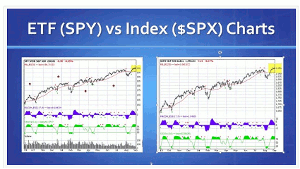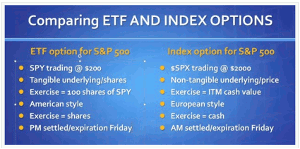Alan Ellman of TheBlueCollarInvestor.com compares and contrasts index options and ETF options and suggests when to trade one or the other.
Writers of covered calls and cash-secured puts use stocks or exchange-traded funds as the underlying securities. It is the value of these securities that give value to our option premiums. For example, we will buy back an option when share price moves down causing the corresponding option to decline in value as well. We may also buy back an option when share price rises exponentially causing the strike sold to move deeper in-the-money and the time value of that option now nearing zero. The relationship between share value and option premium is critical to our covered call writing and put-selling results. In this article, I will discuss another underlying security, the stock index and the options associated with them—index options—and I will compare them to options associated with similar exchange-traded funds or ETFs.
Definitions
Stock Index
A stock index is a statistic that reflects the composite value of a basket of stocks. Stocks listed within an index bear similar characteristics such as trading in the same stock exchange, belonging in the same industry, or having comparable market capitalizations.
Exchange-Trade-Fund (ETF)
An ETF is an investment fund traded on stock exchanges, much like stocks. An ETF holds assets such as stocks, commodities, or bonds, and trades close to its net asset value (per-share dollar amount of the fund is calculated by dividing the total value of all the securities in its portfolio, less any liabilities, by the number of fund shares outstanding) over the course of the trading day. Most ETFs track an index, such as a stock index or bond index.
Charting (SPY) (ETF) and (SPX) (Index Fund)

SPY and SPX charts of the S&P 500
Click to Enlarge
The two charts look exactly the same with the ETF price trading @ $200 and the Index fund price trading @ $2000. To get a better understanding of the differences between an ETF option and an index option, I created this comparison chart:

Comparing ETF and Index Options
Click to Enlarge
Exercise of index options
If SPX was priced @ $2000 and the $2000 call was priced @ $10, the breakeven would be $2010 and any price above $2010 would result in an account credit and any price below $2010 would cause an account debit. This is known as cash-settlement. The maximum loss is the amount paid for the call option. The maximum gain is theoretically unlimited. European style index options can only exercised on the day of expiration while ETF American style option can be exercised at any time from the purchase or sale of the option through expiration Friday.
Summary
The main differences between equity (ETF) and index options occur primarily in the underlying instrument and the method of settlement. Many of our members have been using ETF options as a core income-generator in our covered call writing and put-selling portfolios. Index options can be used by buying and selling calls and puts depending on market outlook.
By Alan Ellman of TheBlueCollarInvestor.com





















